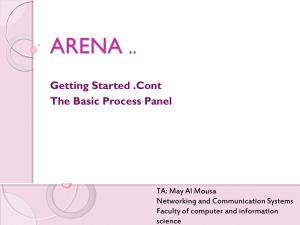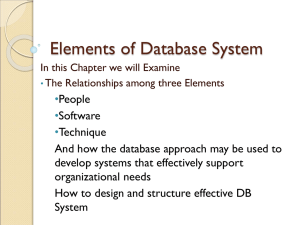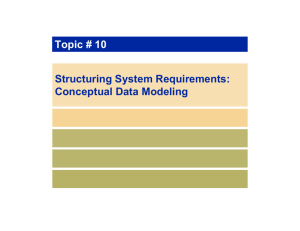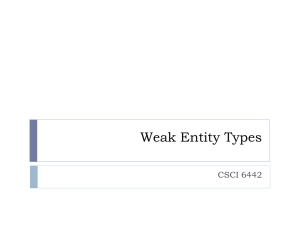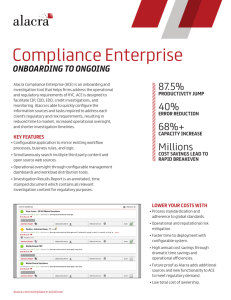Chpater 6 View
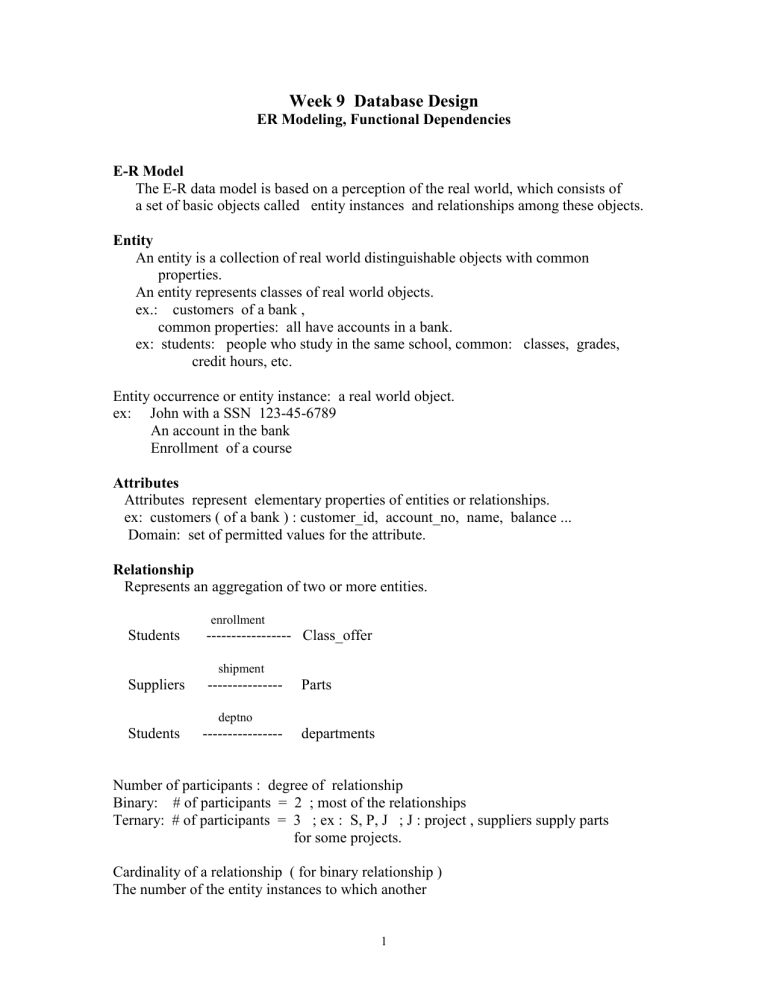
Week 9 Database Design
ER Modeling, Functional Dependencies
E-R Model
The E-R data model is based on a perception of the real world, which consists of a set of basic objects called entity instances and relationships among these objects.
Entity
An entity is a collection of real world distinguishable objects with common
properties.
An entity represents classes of real world objects. ex.: customers of a bank , common properties: all have accounts in a bank. ex: students: people who study in the same school, common: classes, grades,
credit hours, etc.
Entity occurrence or entity instance: a real world object. ex: John with a SSN 123-45-6789
An account in the bank
Enrollment of a course
Attributes
Attributes represent elementary properties of entities or relationships.
ex: customers ( of a bank ) : customer_id, account_no, name, balance ...
Domain: set of permitted values for the attribute.
Relationship
Represents an aggregation of two or more entities. enrollment
Students ----------------- Class_offer shipment
Suppliers --------------- Parts deptno
Students ---------------- departments
Number of participants : degree of relationship
Binary: # of participants = 2 ; most of the relationships
Ternary: # of participants = 3 ; ex : S, P, J ; J : project , suppliers supply parts
for some projects.
Cardinality of a relationship ( for binary relationship )
The number of the entity instances to which another
1
entity instance can map under that relationship.
(1) one to one
Department Department Head
(2) One to many and many to one
Manager Employee
(3) many to many
Player Skills
E-R diagram
Rectangles
Ellipses
Diamonds represent represent represent entities attributes relationships
Lines represent link ( entity-attribute)
(entity-relation-entity)
6. Application of E – R model ( Mapping rules 1 through 4 on the text book )
Mapping a real world system to a RDBMS
Identify the entities, relationships, attributes in your system.
Entities --> tables
Attributes of each entity --> columns.
Relationships --> tables , like SP ( S#, P#, QTY );
QTY descriptive attribute of relationship
or ---> extend the current table, adding a new attribute.
2
Functional Dependency
[ Functional Dependency ]: or FD
X, Y : subset of the set of attributes of relation R
Y is functional dependent on X if every possible value of X uniquely determines the value of Y .
Notation: X
Y
We simply say: Y is dependent on X or
X determines Y .
Definition ( formal ):
Given any two rows r
1
and r
2
in relation R , and X, Y are attributes of R,
if r
1
(X) = r
2
(X) then r
1
(Y) = r
2
(Y).
(if r
1
and r
2
agree in value for X, then they agree in value for Y ).
Assume there will be no change in the table,
A B .... x1 x2 x5 x3 x2 x4 y1 y4 y1 y2 y4 y3
A
B
Which FDs are satisfied in the following table (content of the table will never change ).
A a1 a1 a2
B b1 b2 b2
C c1 c1 c2
D d1 d2 d2 a2 b3 c2 d3 a3 b3 c2 d4
A C ; AB D, etc....
Trivial dependencies
X
Y ; if Y is subset of X ( Y
X )
Full Functional Dependency
Y is fully functional dependent on X if (1) X
Y
(2) Y is not FD on any proper subset z of x. [ No z
Y , z
X ]
Armstrong’s Axioms
(inference rules ) ( O'Neil p335):
3
1. Inclusion rule
2. Transitivity
3. Augmentation
if
(Y
X) Y is subset of X
X
Y and Y
Z
X
Y
then
X
Y
X
Z
XZ
YZ
Note trivial
YZ means Y
Z
These rules are: ( F: a set of FD on R ) using inference rules one can get
Complete : for a given F of FDs --------------------------------> F +
Sound : do not generate any incorrect FD.
Derived rules : ( O'Neil P 336) if then
4. Union
5. Decomposition
6. Pseudo transitivity
X
Y and X
Z
X
YZ
X
Y, YZ
W
X
YZ
X
Y and X
Z
XZ
W
Closure of Set of Dependencies
Closure of F : F +
Definition of F + : the closure of F, to be the set of ALL FDs (functional dependencies)
that are logically implied by F.
i.e. F
+
= { X
Y | F |= X
Y } sample:
R = ABC F = { A
B, B
C }
F
+
consists of all implied dependencies ( list of some of the members of F
+
)
ABC
AB,
AB
BC,
A
C
BC
B,
C C,
C
,
.
4





